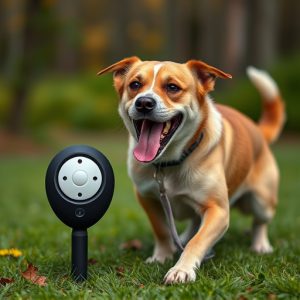Stationary vs Mobile Dog Repellents: A Comprehensive Comparison
Animal control sonic repellents offer non-lethal wildlife management through sound waves. This analy…….
Animal control sonic repellents offer non-lethal wildlife management through sound waves. This analysis focuses on stationary vs. mobile dog repellent systems, highlighting their unique pros and cons in a Stationary Vs Mobile Dog Repellent Comparison. Stationary systems provide consistent, chemical-free deterrence over long periods, ideal for gardens, parks, or commercial properties but require installation and maintenance. Mobile devices offer flexibility, targeting specific areas without impacting the environment, perfect for dynamic settings like farms or quick applications like protecting livestock. Choosing between them depends on budget, scope of the challenge, and environmental conditions.
“In the realm of animal control, sonic repellent systems have emerged as innovative solutions for managing unwanted dog intrusions. This comprehensive guide delves into the heart of these technologies, offering a detailed Stationary vs Mobile Dog Repellent Comparison. From understanding the principles behind sonic repellents to exploring their advantages and drawbacks, we unravel the intricacies. Whether you’re a homeowner or a business owner, this article equips you with knowledge to make an informed decision regarding the implementation of stationary or mobile dog repellent systems.”
- Understanding Animal Control Sonic Repellents
- Stationary Dog Repellent Systems: Pros and Cons
- Mobile Dog Repellent Systems: Advantages and Applications
- Making an Informed Decision: Comparing Stationary vs Mobile
Understanding Animal Control Sonic Repellents
Animal control sonic repellent systems have gained popularity as a non-lethal method to deter and manage problematic wildlife. These devices use sound waves to create an uncomfortable or unpleasant experience for animals, encouraging them to stay away from treated areas. Understanding how they work is crucial when considering their effectiveness in various scenarios.
One key distinction lies in the comparison between stationary and mobile dog repellents. Stationary systems are typically installed in specific locations, such as gardens or perimeters of properties, emitting continuous sound waves to keep animals at bay. In contrast, mobile repellents offer versatility, allowing users to move them from place to place, catering to different environments and animal behavior patterns. When assessing their performance, factors like frequency ranges, power output, and the specific needs of target animals play significant roles in the choice between these options.
Stationary Dog Repellent Systems: Pros and Cons
Stationary dog repellent systems are designed for long-term installation in specific areas, such as gardens or parks, where they emit ultrasonic sounds that dogs find unpleasant. The primary advantage is their consistency; they provide a continuous and reliable deterrent over an extended period. This makes them ideal for areas where persistent dog intrusion is an issue, like commercial properties or residential neighborhoods with heavy foot traffic. Additionally, these systems are generally more environmentally friendly as they don’t rely on chemicals.
However, stationary systems have drawbacks. They require initial installation costs and regular maintenance to ensure optimal performance. Moreover, their effectiveness can be limited by external factors such as weather conditions and the system’s range. In contrast, mobile dog repellent devices offer flexibility, being easily portable and suitable for temporary or situational use. When considering a Stationary Vs Mobile Dog Repellent Comparison, understanding these pros and cons is crucial in determining the most appropriate solution for specific needs.
Mobile Dog Repellent Systems: Advantages and Applications
Mobile dog repellent systems offer a convenient and effective solution for managing canine behavior in various settings. Unlike stationary repellents, these portable devices provide flexibility and ease of use, making them ideal for outdoor spaces like parks, gardens, and even farms. One significant advantage is their ability to target specific areas, allowing users to protect desired zones without affecting the surrounding environment. This feature is particularly useful in urban areas where maintaining peaceful co-existence with stray dogs is essential.
When comparing mobile and stationary dog repellents, the latter often requires more setup and maintenance. Stationary systems may be less practical for frequent relocations or dynamic environments. In contrast, mobile systems can easily adapt to changing landscapes, making them versatile for different applications. Whether it’s deterring dogs from entering a specific garden bed or protecting livestock in an open field, these devices offer a quick and efficient response without compromising on effectiveness, providing a clear advantage over traditional stationary repellents.
Making an Informed Decision: Comparing Stationary vs Mobile
When considering an animal control sonic repellent system, one of the key decisions is whether to opt for a stationary or mobile solution. A Stationary Vs Mobile Dog Repellent Comparison reveals distinct advantages and drawbacks for each type. Stationary systems are typically installed in specific areas and are highly effective for targeted problem zones. They offer consistent protection without interference from external factors like weather or movement. However, they require physical installation and might not be easily adjustable to cover changing needs.
On the other hand, mobile systems provide flexibility, allowing users to move them between locations as needed. This is particularly advantageous for those dealing with roaming animals or varying environmental conditions. Mobile repellents can be quickly deployed in new areas, but they may offer slightly less consistent protection compared to stationary units due to potential power sources and weather impacts. The choice ultimately depends on the specific requirements, budget, and scope of the animal control challenge at hand.
When comparing stationary versus mobile dog repellent systems, both have their unique advantages. Stationary systems offer consistent protection and are ideal for confined spaces, while mobile options provide flexibility and are perfect for larger areas or dynamic environments. Consider your specific needs, budget, and the behavior of the target animals to make an informed decision. A thorough analysis of these factors will help you choose the best animal control sonic repellent system for your situation, ensuring a peaceful coexistence with unwanted canine visitors.


